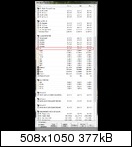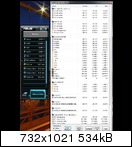Martin said:
Then I'm sorry, but there's nothing I can do about this, since I have to trust the ASUS own tool.
Martin, Just a FYI in case you are not aware of this. I own an ASUS SaberTooth P67 board, that uses ASUS's AI Suite II monitoring and utility programs, including their Thermal Radar application. That is similar if not identical to the ASUS program the OP is using.
After I updated the UEFI on this board (a few UEFI updates ago), the CPU temp (not core temps) Thermal Radar reports suddenly dropped by ~10C or more, the idle temps being the lowest. This temp difference is also seen in the UEFI. I was getting sub-ambient CPU temps at idle, which I knew was wrong. I flashed the UEFI back to the previous version, and the CPU temp magically returned to the values I normally saw. Flashed back to the new UEFI, and the CPU temp was again at least 10C lower.
To make a long story short, I finally found in the release notes of a UEFI update for a different ASUS P67 board that they had changed the CPU temp reading from Tcase (or Tjunction, I forget) to a sensor in the CPU socket, I believe.
The main thing that helped me realize this was HWiNFO64. Your "CPU Package" (the Original Name for that data in your Configure option) temp reading did not change after the UEFI update (of course.) It's value did match the value shown in Thermal Radar with the earlier UEFI. The difference between the two after the UEFI update is what helped me realize what had happened, in general.
Best of all, your "CPU" temp reading (a different reading than CPU Package) shows the same value as the incorrect/different temp reading shown in Thermal Radar! That really confirmed for me that ASUS had switched what data was used to display the CPU temp.
IMO, ASUS did this due to complaints from some owners of their P67 boards about the CPU temp being to high when using the UEFI. Since none of the CPU power saving options are active while using the UEFI, and it apparently uses one core of the CPU at a high level, almost 100%, the CPU get a little warm with the stock cooler, poorly installed coolers, and/or poorly ventilated cases. I really don't know if that is true, but several UEFI versions later, and after my submission of a problem report to ASUS, and ranting about it in their forum, nothing has changed. Regardless, IMO it is a dirty trick, potentially dangerous to the users hardware, and shows disrespect for their customers.
So let me thank you for creating and maintaining a honest and reliable PC hardware monitoring tool, it is the ONLY one I use on all my PCs. Not that I think you would, but please don't ever change what temperature data you display because someone thinks it is wrong, or are pressured to do so for some reason. As I write this and glance over at the HWiNFO64 Sensor Status display, the cores of my i7-2600k are usually idling at 1.6GHz, but change occasionally to the OC speed of 4.6GHz. My real CPU temp varies between 25C and 30C, while the ASUS CPU temp, that I can also see as I said, is showing 14C - 15C. While it is winter where I am in the US, I can assure you that my room temperature is not 60F or less.
Excellent work Martin, thanks so much!
PS: If you run HWiNFO at the same time as Thermal Radar, Thermal Radar gets bad data for some reason, and issues random warnings about temps, voltages, etc. Thermal Radar does that when most any other hardware monitoring program is running, in my experience.



